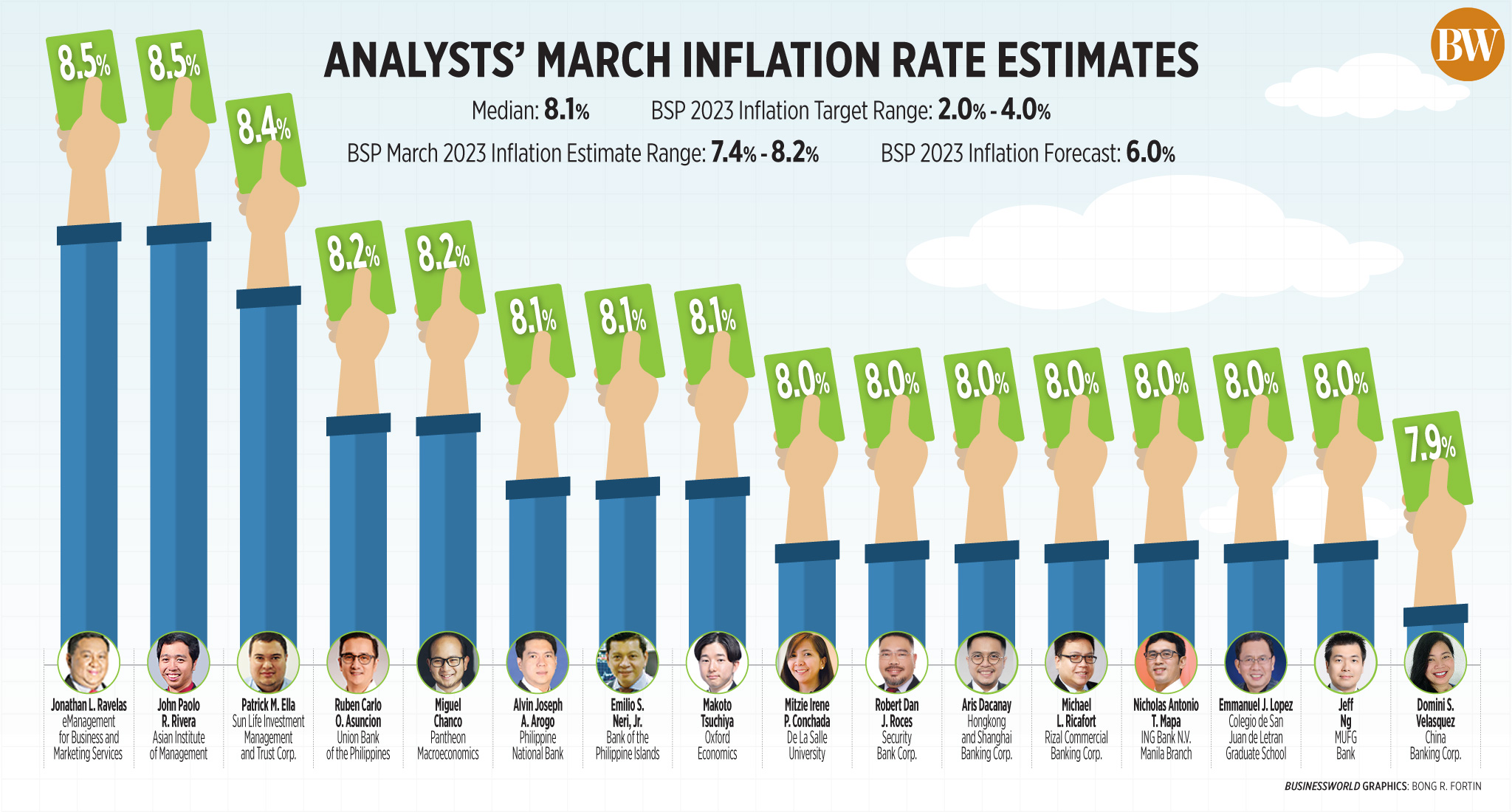Inflation likely slowed in March — poll

By Keisha B. Ta-asan, Reporter
INFLATION likely further slowed in March amid lower pump prices and a drop in prices of some food items, analysts said.
A BusinessWorld poll of 16 analysts yielded a median estimate of 8.1% for March inflation, near the upper end of the 7.4% to 8.2% forecast given by the Bangko Sentral ng Pilipinas (BSP) last week.
If realized, the median estimate will be slower than the 8.6% in February, but much faster than the 4% print in March 2022.
March would mark the 13th straight month that inflation surpassed the BSP’s 2-4% target range.
The Philippine Statistics Authority (PSA) will release the latest consumer price index (CPI) data on April 5 (Wednesday).
“We expect CPI inflation to slow to 8.1% in March, primarily on the back of lower energy prices,” Oxford Economics assistant economist Makoto Tsuchiya said in an e-mail.
Fuel retailers lowered pump prices in March. For the month, pump price adjustments stood at a net decrease of P0.65 a liter for gasoline, P1.75 a liter for diesel, and P3.25 a liter for kerosene.
“The impact of non-monetary interventions to tame inflation should have also been evident (in March),” Hongkong and Shanghai Banking Corp. economist for the Association of Southeast Asian Nations (ASEAN) Aris Dacanay said in an e-mail.
The government earlier this year approved the importation of 21,000 metric tons of onions, which helped bring down the price of red onions to P143 per kilogram (kg) in March from P535 per kg in January, Mr. Dacanay said.
He also noted the drop in prices of some vegetables like eggplants and Chinese cabbages in March.
China Banking Corp. Chief Economist Domini S. Velasquez said prices of eggs also went down as the avian flu remains contained, while fish prices slipped as the fishing season resumed. However, this may be offset by the rising prices of rice and meat, she added.
“Other commodities showed mixed performance for the month. Electricity in Meralco-serviced (Manila Electric Co.) areas are up due to high generation charges brought about by the shutdown of Malampaya,” she said.
Meralco hiked the overall rate to P11.4348 per kilowatt-hour (kWh) in March from P10.8895 per kWh a month ago due to an increase in generation charge.
The generation charge went up by P0.4636 to P7.3790 amid the maintenance shutdown of the Malampaya gas production facility from Feb. 4 to 18. Power plants supplied by Malampaya ran on more expensive alternative fuels to ensure continuous power supply during the two-week shutdown.
Ms. Velasquez said the higher generation charge in April and the looming El Niño may continue to drive up utility rates.
Philippine National Bank (PNB) economist Alvin Joseph A. Arogo said the lagged and second-round impact of higher prices from last year has not faded, but base effects will “play a big role” for the rest of the year.
Since March 2022, headline inflation has been above the 2-4% target range.
Mr. Tsuchiya also said inflation may continue to slow given easing supply-side pressures on food and energy, as well as softening domestic demand.
Union Bank of the Philippines, Inc. Chief Economist Ruben Carlo O. Asuncion said he does not expect a rapid disinflation this year. His full-year inflation forecast is 7.1%, higher than the BSP’s 6% average forecast.
“We see food to remain elevated primarily due to supply constraints and will not be remedied by the BSP’s hiking interest rates,” Mr. Asuncion said.
Ms. Velasquez said core inflation is still expected to remain elevated at around 7.8% in March, before “slowly trending downwards.”
“Moreover, prices of some food commodities seem to be moving upwards, rice and meat in particular. We are still awaiting greater non-monetary interventions to make sure food prices are brought down,” she added.
Core inflation, which discounted volatile prices of food and fuel, quickened to 7.8% in February from 7.4% in January, the fastest pace in over 22 years.
Security Bank Corp. Chief Economist Robert Dan J. Roces said core inflation may remain high if not flat in the next two months “as this responds with a lag from broader price effects.”
“Given these, the BSP will remain cautious as risks remain. With the next policy meeting in May, the central bank will have two months’ worth of data to consider as to its next move,” Mr. Roces said.
“We do think it has done much of the heavy lifting, and monetary policy can only do so much. Thus, we think there is a higher chance that it may decide to pause at the current policy rate,” he added.
The BSP has raised rates by a total of 425 basis points (bps) since May 2022, bringing the policy rate to 6.25% — the highest since 2007.
“If we’re right, and inflation continues to fall in the coming months before the BSP Monetary Board meets next in May, then I suspect that they will have enough confidence to hit the pause button on its tightening cycle,” Miguel Chanco, chief economist for emerging Asia at Pantheon Macroeconomics, said in an e-mail.
For Mr. Dacanay, inflation will remain well above the BSP’s 2-4% target range.
“We expect the BSP to whip out another 25-bp hike (to 6.5%) at the next Monetary Board meeting before eventually pausing its tightening cycle,” he said.
The Monetary Board’s next policy review is on May 18.




